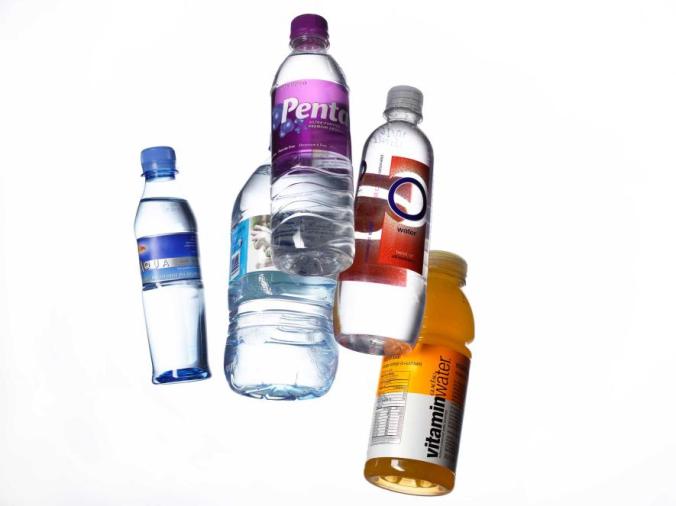
One definition of the word “mania” is “excessive or unreasonable enthusiasm.” I can think of no better word to describe America’s apparent love of anything bottled in plastic, but in particular, bottled water.
(They also love plastic grocery bags.)
See:
https://atomic-temporary-93487818.wpcomstaging.com/2017/08/01/save-the-sea-go-plastic-free/
In 2015, Americans bought the equivalent of 1.7 billion half-liter bottles of water every week, more than five bottles of water for every person in the country every single week, or one shrink-wrapped 24-pack of bottled water per week for a family of four.
As far as the water bottles themselves, it required about one-third pint of oil to fabricate, purify, fill, and transport each half liter of bottled water in the U.S. in 2015. That equates to more than 70 million total gallons (1.7 million barrels) of oil in one week, enough to heat 2,000 homes in the Northeast for one year. Plus, it takes a half gallon or more of water to fabricate each bottle.
A glance at the allocation of shelf space in a supermarket, a Costco, or a Walmart is the best indicator of our love affair with water encased in plastic. A mere 30 years ago, the sight of a disposable plastic water bottle would have been unusual. In 2016, Americans for the first time consumed more bottled water than carbonated beverages (“soda” or “pop” or “soda pop,” depending on your regional background).
Of course the line separating plain bottled water from soda’s stepchildren, i.e., sports drinks (with all their implied performance benefits), has become somewhat muddled. Does the addition of a few “micronutrients,” sugar (in all its various guises and disguises), vitamins, and sundry salts justify paying four or five dollars for what is essentially water with a few cents worth of additives thrown in, most of which are not needed by anyone who sticks to a decent diet? Many Americans seem to think so.
A suggestion–follow my simple recipe to make your own sports drink: To a recycled gallon container, add a cup of citrus juice and a pinch of table salt, a few ice cubes, and top it off with tap water. Unless you live in Flint, Michigan or have untreated well water, municipal water supplies are generally safe.
And unless you drink Fiji water or some other liquid exotica wrapped in plastic, the bottled water you’re sipping right now probably flowed from a public water supply. In fact, at least half of all bottled water comes from the tap. Although the National Resources Defense Council found that most bottled water is of good quality, does that make it better than tap water? The most recent tests by the NRDC of 103 bottled waters showed that tap water was as safe as bottled. Indeed, there are few standards and little regulation of bottled water.
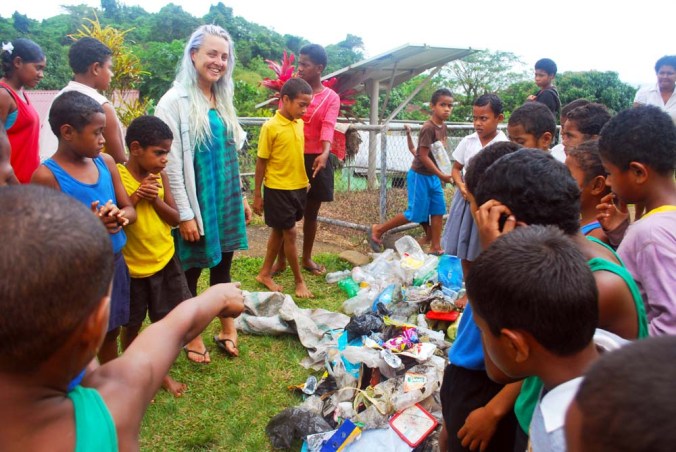
Speaking of Fiji, even that “pristine” Pacific paradise is under attack from its own water bottles and other plastics trash.
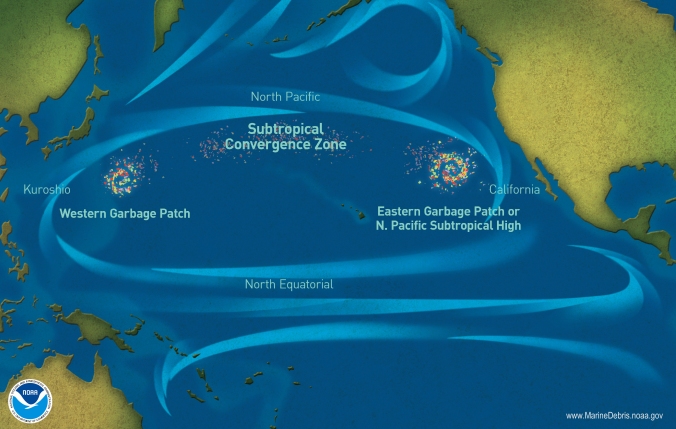
Many of these plastic bottles and other plastics trash end up in the “Great Pacific Garbage Patch,” which is somewhat of a misnomer because it is not always readily visible.
The gyres comprising the patch are just concentrations of debris found throughout the oceans, from pole to pole. The plastics components range in size from a few microns and larger to whole bottles that once contained anything from pills to, yes, water.
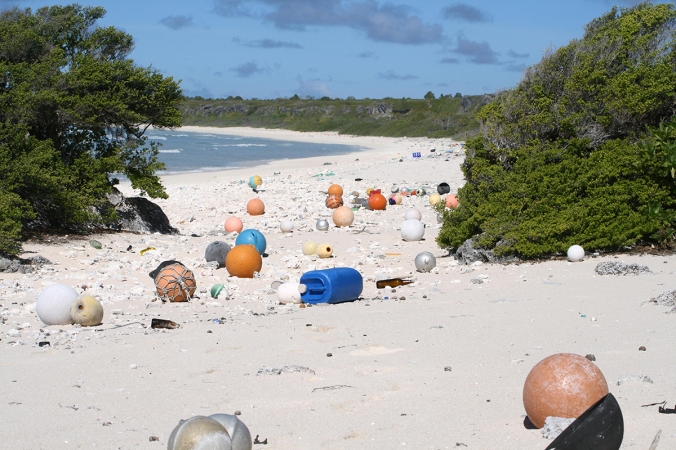
And far from Fiji lies Henderson Island, an uninhabited speck of land halfway between Australia and South America. A recent expedition led by Jennifer Lavers at the University of Tasmania in Australia found 38 million items of rubbish weighing almost 20 tons spread across its beaches.
The plastics do break down mechanically, but biodegrade only slowly, if at all. The smallest particles are taken up by primary feeders like plankton, then work their way up the food chain to the tuna sandwich you had for lunch yesterday and washed down with a bottle of Fiji water. In that journey, those particles might absorb hydrophobic pollutants like PCBs and pesticides like DDT, human inventions that can cause interesting genetic mutations that often lead to cancer.
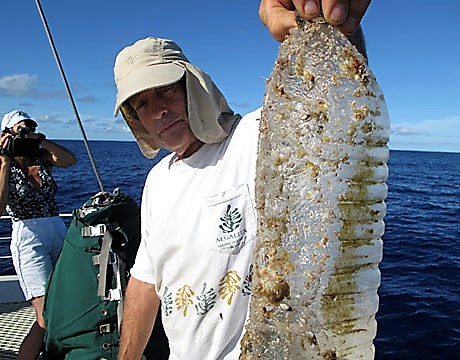
Americans love their myths, whether they involve vitamins, “health” drinks, sports figures, or any of a myriad of beliefs based on self-deception. Why else would we buy millions of dollars’ worth of copper bracelets to “cure” arthritis? Should there be a penalty for believing the myth of bottled water?
Only 10 percent of the billions of plastic bottles produced are recycled, mainly because many municipalities do not have recycling programs in place. Bottle deposit programs, a penalty of sorts, do work, but the infrastructure and associated costs make them unpopular.
The best approach, and the most realistic one, seems to be single-stream recycling tied to programs of consumer education. Such an approach is simple, easy to implement, and can contribute to a municipality’s bottom line. For Indian River County in Florida, the state-mandated recycling rate of 75 percent by 2020 appears attainable. Self-interest alone should inspire residents to help the county reach that goal.
Publisher’s Note: The September 18, 2017 issue of TIME reported that “The majority of tap water contains plastic pollutants, according to a Orb Media study, which found in 83% of 159 drinking-water samples from around the world. Scientists are unsure of health implications.”
*Bill Britton is a freelance writer and formerly an editor for John Hopkins University Press, ABI Research, and Elsevier Science, and is a frequent contributor to Vero Communiqué.
Sources:
- http://news.nationalgeographic.com/2016/04/160420-bottled-water-sales-record-high-despite-environmental-opposition/
- http://www.businessinsider.com/facts-bottled-water-industry-2011-10?op=1
- https://www.nrdc.org/stories/truth-about-tap
- http://www.diveplanit.com/marine-environment/fast-track-fiji-cleaning-oceans/
- https://www.newscientist.com/article/2131051-remote-pacific-island-found-buried-under-tonnes-of-plastic-waste/
- https://www.newscientist.com/article/dn21791-water-striders-thrive-on-pacific-garbage-patch/
- http://discovermagazine.com/2008/jul/10-the-worlds-largest-dump
- http://www.baltimoresun.com/news/opinion/readersrespond/bs-ed-bottle-deposits-letter-20130802-story.html
- http://archive.tcpalm.com/news/shaping-our-future/property-values/indian-river-county-says-new-single-stream-recycling-program-showing-increasing-participation-2ad202-368521311.html
Just a couple of notes: “pesticides like DDT, human inventions that can cause interesting genetic mutations that often lead to cancer.” A number of years ago, a movie called “Not Evil, Just Wrong” came out as a counter to Gore’s “An Inconvenient Truth”. Along with pointing out some scientific facts that showed Gore’s theories to be incorrect, the movie spent a good deal of time dispelling Rachael Carson’s myth about DDT. The movie producers went to Africa where a push by the US and UN had caused the banning of DDT. Thousands of children were dying daily because of mosquito spread malaria. One American ‘environmental warrior’ there refused to accept this fact even after being confronted by the mother of two dead children. This is the price we have to pay. Here is an article on the same subject.
http://www.thenewatlantis.com/publications/the-truth-about-ddt-and-silent-spring
Myths about vitamins? Which vitamins and do you have research? Many physicians believe that vitamin supplements are effect in helping the body in a number of ways including calcium for post-menopausal women and Vitamin D is recommended now for everyone.
“Should there be a penalty for believing the myth of bottled water?” You tell me – what would you suggest? I’m a flat-earther and some say that I should be pilloried in the public square.
LikeLike
smehiel: Re DDT, etc.: Banned for agricultural uses worldwide by the 2001 Stockholm Convention on Persistent Organic Pollutants, the use of DDT is still permitted in small quantities in countries that need it, with support mobilized for the transition to safer and more effective alternatives.
And from Scientific American: “Scientists have already found a strong potential link between pesticides and Parkinson’s disease. Now, a preliminary study released in January suggests that the pesticide DDT, which degrades so slowly that it continues to linger in the environment more than 40 years after the U.S. Environmental Protection Agency banned its use in the U.S., may also contribute to Alzheimer’s.”
Also: DDT can build up in the fatty tissues of animals that are exposed to it. This accumulated build-up is known as bioaccumulation, and DDT is described by the EPA as a persistent, bioaccumulative toxin. Because of this bioaccumulation, DDT remains in the food chain, moving from crayfish, frogs, and fish into the bodies of animals that eat them. Therefore, DDT levels are often highest in the bodies of animals near the top of the food chain, notably in predatory birds like eagles, hawks, pelicans, condors and other meat-eating birds (and humans). Since DDT was banned in the U.S., the bald eagle population has rebounded. DDT also has serious health effects on humans. According to the EPA, DDT can cause liver damage including liver cancer, nervous system damage, birth defects and other reproductive harm.
Re vitamins: “The general healthy population does not need vitamin and mineral supplements. Supplements can be taken as pills, powders and liquids. These are not necessary to achieve or maintain good health. The best way to achieve health and get all essential nutrients is by eating a diet containing a variety of foods.” The exceptions to this are then listed, which I should have briefly discussed.
http://healthunit.org/nutrition/foodsecurity/vitamin.htm
Also, some people suffer from what I call “The Doctor Oz Syndrome,” such that they latch onto the latest supplement fad. If you were to buy into all of the good doctor’s recommendations, you would need to add a storeroom to your home.
Re the penalty for the bottled water myth: I believe I explained the problems with such a penalty (deposit programs). The non-penalty solution is single-stream recycling as stated.
LikeLike
Tell all of that to the dead children of Africa.
LikeLike
smehiel: I’m not sure of the reasoning behind your comment. DDT is now being used in Africa, but very reluctantly because of the multitude of health problems associated with its use. But you are welcome to use it in and around your home. Go to: http://www.premiumtimesng.com/news/141150-african-countries-adopt-controversial-deadly-chemical-ddt-for-malaria-treatment.html
LikeLike